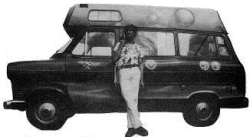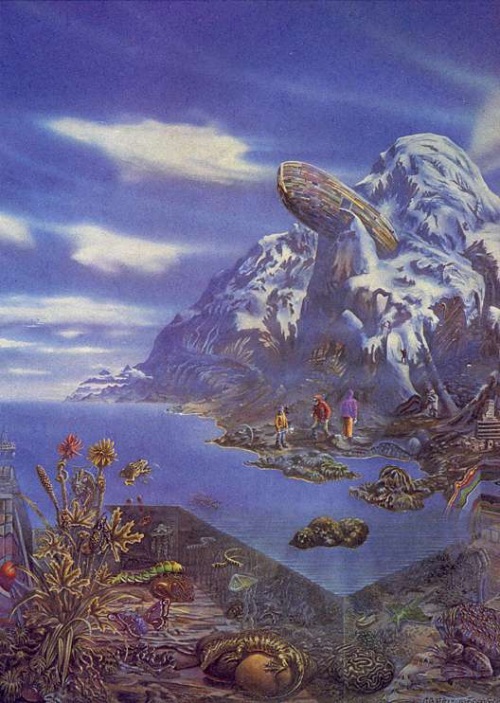

One day, some years ago, Rich Shenfield was browsing through the wares on offer in a Southampton Army Surplus store, looking for a greatcoat. He bumped into a friend, who had just started a software house. The friend was Mark Eyles, the software house was Quicksilva, and Mr Shenfield was hired to provide artwork for their cassette inlays and advertising material. Thus began Rich Shenfield’s association with the software industry...

Rich Shenfield and a very mobile example of his art, snapped in sunny Ludlow. Just before the local traffic warden caught up with him...
Richard Shenfield is a man of many talents. He left school with A levels in Physics, Maths and Chemistry (and art!) and was set to become an engineer, taking up a place on an electronics degree course at Southampton University.
After a year of electronics, however, his artistic nature got the better of his engineering side and he resigned from the course, spent a year painting and preparing a portfolio before taking up a place at Bath Academy of Art. While he was at college, he began freelancing for Quicksilva, in the days when the company operated from a terraced house which was bursting at the seams with cassettes and dismantled arcade machines — much to the dismay of a certain landlord who arrived one day to collect the rent to find most of the furniture had been moved into the garden!
Since leaving college, Rich has pursued a free lance career, continuing to provide illustrations for Quicksilva and a number of other commercial clients. ‘Commissions help to pay the rent,’ he explained, ‘but I am always painting for myself, following my own interests. If I’m not working on a commission I am almost always working on a painting for a friend, or for myself’.
And his technological background enters his art — one painting, which formed part of a travelling exhibition, involved a fair bit of electronic wizardry which triggered off light emitting diodes and played an audio tape if sensors picked up movement. The gizmo even had a back-up battery, which cut in if the gallery owner unplugged the painting in an attempt to silence it!
‘I’m keen to bridge the gap between engineering and art — people say you can’t move from one to the other. On the one hand, artists can be luddites, claiming that engineering has little to offer, while engineers can consider art to be a waste of time as it does not deal with the mathematical values which form the basis of engineering thought.’
Rich Shenfield is fascinated by older civilisations and the contrasts between their level of technology and that of the modern world. He has recently returned from a nine month spell in India, where he spent many months living and working with ancient communities whose engineering skills are comparable to those that could be found in Europe five hundred years ago. The experience of visiting the Indian continent has recharged his artistic batteries, providing the artist in him with a variety of new experiences and images.
‘For instance I came upon a ruined city containing a temple which was built two thousand years ago. Everything bar the major buildings had been etched away over the years leaving a network of towers linked by roads — and the area had a striking resemblance to the architecture of Large Scale Integration microchips.
‘And it was intriguing to disappear into the desert for a couple of days — the ‘moonland’ in Kashmir is just a vast tract of dust and rock, where the geology is naked. Returning from the desert, having cut yourself off, you see things in a new detail, which is very useful for drawing!
‘Having spent three years painting alien landscapes, to spend nine months in an area of this world which is totally alien was like spending nine months on another planet — it was like being in a huge adventure game.’
Richard’s airbrush paintings are only a part of his output — his thesis at college was on 3D television, and he has been working with holographs for a couple of years with a firm called Holographix, producing 3D logos for computer companies and developing the techniques involved in creating images using laser light. He also has an animated film under his belt, produced with a Spectrum — mind you, he did use a 16mm camera to boost the computer’s memory!
And he uses computers in creating pictures. The cover for Mined Out for instance, was partly created on a mainframe using vector graphics to produce a line output which he then airbrushed over. This is an area of work he would like to get involved in further: ‘If anyone out there has a mainframe with a wonderful multi-colour, high resolution monitor I can use, I’d love to meet them. I simply can’t afford fifteen or twenty thousand pounds worth of equipment for my back room! Unfortunately the resolution from all but the most expensive systems is simply not coherent enough to be of much use to me.’
During the summer months, Rich has got into the habit of travelling the country in a caravanette, with his 12 volt airbrush, painting whenever and wherever the fancy (or a commission!) takes him. When he visited us in Ludlow, he had just finished designing the circuitry for a top-of-the-range stereo amplifier, which will deliver a massive 500 Watts per channel of almost distortion free sound.
A multimedia man, Mr Shenfield bade us goodbye, on his way to purchase some cellulose paint with which to decorate his van....
